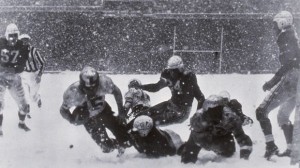In the pre-season, I wrote three pieces on Cleveland Browns rookie Trent Richardson. As part of a thought experiment, I wondered who would lead the NFL in rushing yards from 2012 to 2021? I narrowed my finalists to LeSean McCoy, Beanie Wells (was I drunk?), DeMarco Murray (ouch), Richardson and the rest of the rookies, and then a few college running backs. I concluded that Richardson was the obvious frontrunner, with McCoy, Doug Martin, and Marcus Lattimore (double ouch) as the next best bets. I’m not really sure 2012 helped clarify the issue, although Martin and Alfred Morris certainly raised their chances.
Then in August, I looked at the production of the highest drafted running back in each draft class. I discovered that slightly fewer than half of the highest drafted running backs led their class [1]Note that this only includes drafted running backs. in rushing yards as a rookie; as you can see, “the field” also turned out to be a better bet than Richardson in 2012:
In that post, I also noted that the running back drafted first in his class was slightly less successful over the course of his career: only one-third of the highest-drafted running backs finished with the most career rushing yards in their class.
The final post on the topic ended up being more relevant to Alfred Morris than Richardson. In August, I compared how the top rookie running back performed over the rest of his career relative to the other members of his class. From 1992 to 2002, 10 of the 11 backs to lead their class in rushing yards as rookies ended up finishing with the most career rushing yards. But in recent years, that trend has reversed itself: the odds are long that Ben Tate (2011), LeGarrette Blount (2010), Knowshon Moreno (2009 and competing with Arian Foster and LeSean McCoy), or Steve Slaton (2008) will also finish with the best careers from their class.
So where do we stand on Richardson and Morris? A year later, how much credit do we give Richardson for having been the #3 pick in the draft? For Morris, how much do we downgrade him for being a 6th round pick? And how does the presence of Robert Griffin III complicate things?
[continue reading…]
References
| ↑1 | Note that this only includes drafted running backs. |
|---|


